|
|
|
|
| |
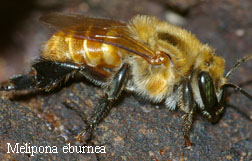 |
Honey from stingless bees About 800 species of stingless bees are found throughout tropical regions of the World, ranging from such ecologically diverse habitats as humid rainforest to dry savanna or cerrado. Their greatest diversity and abundance, however, is in the Amazonian rain forest. While they range in size from only a few mm to larger than the honey bee (Apis mellifera), they all live in colonies where they care for the brood (the new bees) laid by the colony mother, or queen. Some colonies contains thousands of individuals. Working females are constantly flying in and out of the colony to gather what is needed for sustaining the large family. Most importantly the foraging workers gather honey and pollen used as provision for the young bees (larvae) being reared. The bees will usually store a large amount of both honey and pollen during favorable times which they can use later. If properly managed, the honey can be harvested from the stingless bees without damaging or weakening the colony. The taste of stingless bee honey is experienced different by different people, but generally it is called very sweet and pleasant, almost acidic and with a boost of floral fragrances. The highly desired Tetragonisca honey is a little more acidic compared to honey from Melipona due to the plants visited by these bees.
|
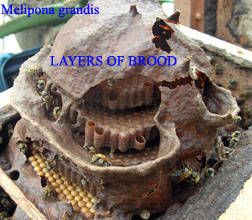
|
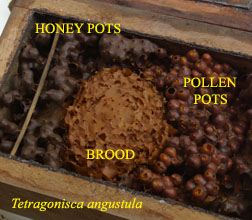 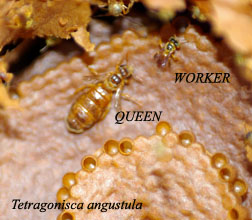
|
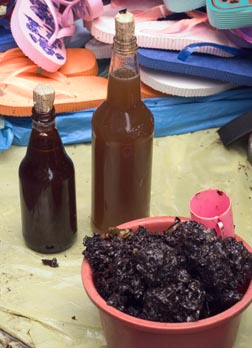 |
Traditional use of honey from stingless bees The use of stingless bee honey is known from all of the regions where these bees are found, with possibly most interest in the cultivation in Latin America and Australia (called sugar-bags there). The best documented use of honey from stingless bees comes from the Mayan civilization in the Yucatan peninsula where they use Melipona beechei. Here the bee is called "xunancab" and beekeeping of this species originated independent of hive beekeeping with honey bees in the Old World. "Xunancab" was in the Maya civilization only second in importance to corn (maize) in people's lives and rituals. The honey was used both as honey, but also fermented as "balche", their alcoholic drink. Today the tradition of keeping stingless bees has largely been abandoned in favor of imported honey bees (Apis mellifera) which yields more honey.
In Peru stingless bee honey has been used in traditional medicine for centuries or more, but the actual beekeeping has been limited and most honey for the local market is collected by cutting down trees with entire bee colonies, which are then left to die. Traditionally honey from stingless bees are harvested by squeezing the honey pots with the bare hands and collecting the honey as it pour out of the nest, often contaminated with pollen and brood (bee larvae). This makes the honey particular susceptible to fermentation. The honey is widely used and often sold at local markets. Here the honey may serve both as a sweetener, but more often as part of folk medicine. Stingless bee honey are an important part of different treatments against throat infections (common cold, cough), but are also used in the treatment of fertility problems. While the honey possesses anti-bacterial properties dependent on the botanical origin of the honey, the combination of stingless bee honey with jungle herbs may alter or improve the properties of each remedy to be more specific in the treatment. A typical mixture to combat fever include stingless bee honey (1 part) mixed with sugar cane alcohol (5 parts) and left with the local plant "chuchu-huasi" (Maytenus krukovii) and pollen.
|
| |
|
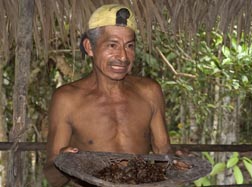 |
How can I tell the difference between honey bee honey and stingless bee honey?
Stingless bee honey is more liquid than the well known honey bee honey. Honey bee honey has a water content of about 20% while the stingless bees has a water content of between 20-42%, depending on the species and the area from where the honey is collected. The high water content in stingless bee honey makes it very prone to fermentation. The flavor is often described as a more flowery than honey bee honey, but it depends largely on the species. There has been relatively little scientific research into the medical properties attributed to honey from stingless bees, but due to the presumption that it is a remedy and the usually low amount of honey produced, the price is much higher than that of honey bee honey (Apis mellifera).
|
|
|
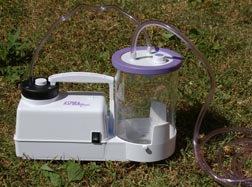
|
How do we collect and store the honey?
We use the modern rational bee hive design as developed by Noguiera-Neto in Brazil, a design that allows us to harvest honey under very hygienic conditions. We use a medical aspirator (AspiraMax MA-520) imported from Brazil to efficiently gather honey from individual honey pots. All of our honey gathering equipment and bottles are boiled for sanitation before each use. The honey is then gathered from the Melipona colony and bottled directly. To avoid fermentation of the honey, we pasteurize the honey by heating it up to 72° C for 15 seconds, as recommended by Noguiera-Neto. The honey should be kept dark and at room temperature, although if necessary to store the honey for an extended period of time, refrigeration may be used to prevent fermentation. For extraction of honey from Tetragonisca hives it is necessary to remove all of the honey pots from the hive and manually extract the honey. The wax produced by Tetragonisca for their honey pots is so delicate that the aspirator collapses the pots when used. Due to this our honey from Tetragonisca may contain tiny fragments of the honey pots.
|
|
|
 |
How to consume the honey you just purchased?
We recommend to use our stingless bee honey against the common cold in a mix of two tablespoons of honey (10 ml) and half a tablespoon of fresh lime (2.5 ml). It is also recommended to add a little garlic if you are coughing. Stingless bee honey is also great in fruit salads; adding it to a bowl full of e.g. banana, pineapple, apple, mangos, grapes, the juice of two oranges, and finally three-four tablespoons (15-20 ml) of stingless bee honey. Fruit flavored yogurt can be added. Of course, the honey can also be used in place of honey bee honey or sugar to add a more exotic flavor, but keep in mind, that honey from stingless bees is a little more runny than what you usually experience with honey bee honey.
|
|
|
 |
Different varieties of stingless bee honey
We keep a range of stingless bees for study. They all have their unique and characteristic honey. Generally we recommend the consumption of honey only from the genera Melipona and Tetragonisca, as well as a few others that we do not sell at the moment. The quantity of honey produced is low compared to honey bees. After a full year we expect to harvest 4-500 ml from a good hive of Melipona. We leave all of the pollen pots untouched for the bees to use and also leave some of the honey pots in the hive for the bee to survive on. The production in Tetragonisca hives is minor, and we extract less than 100 ml from their hives during a year.
|
|
|
 |
Where did your honey come from?
Our colonies are kept in different parts around the city of Tarapoto, San Martin, Peru. Our bees will here visit tall trees in the secondary rainforest along the River Shilcayo or River Cumbaza. They will occasionally encounter a few monkeys or a lone toucan in the trees, while colorful poison-arrow frogs (Dendrobates) sing from the bank of the river. We are not certain how many different trees have been visited for your honey, but guarantee that the honey is completely authentic and not altered or modified by additives or artificial feeding during the honey production. This guarantees a rich and unique flavor to your honey. Supplemental sugar is provided to strengthen the colonies only when we are installing colonies into new hives following reproduction, and thus prevents us from loosing a very valuable genetic resource from our management program.
|
|
|
 |
Rainforest conservation and stingless bees
The stingless bees depend on the rainforest to succeed. Unlike honey bees (Apis mellifera) they do not adapt to low diversity crop systems and will disappear if the rainforest disappear. Therefore the promotion of stingless bees is a very important tool to educate people living in the rainforests about the importance of their surrounding forest. Honey production by native stingless bees is also an ecologically very sound and cheap method to generate a sustainable livelihood in the Amazon rainforest. Production of stingless bee honey provides the farmer with an economic alternative to logging and encourage the conservation of trees as nectar and pollen sources. By developing stingless bee honey programs, we hope to raise the living standard for otherwise marginalized people and contribute to their awareness in conservation of the rain forest and all of its inhabitants.
|
|
|
 |
About us
We are a legally registered Peruvian NGO ("Asociación Civil Melipona"). Since 2002 we have kept and studied stingless bees. Our mission is to promote the keeping of stingless bees throughout the Amazon region in an aim to teach people about conservation and the importance of eco-systems as an sustainable alternative, with the utilization of non-timber forest products like honey from stingless bees. We are still in a pilot-phase developing techniques for keeping stingless bees and pursuing other conservation goals. Our background range from professional entomologist with Ph.D., agronomists, and Peruvian farmers, all united by the curiosity and love for the nature and the native bees.
|
|
|
|
Thank you for reading all of our about page!
|
|
|
|
|
All of our credit card transactions are handled by Paypal on their separate secure site. This provides you with a safe and secure form of payment. We never receive any financial information from Paypal other than their payment from you. Your personal contact information is well protected by Melipona.org and we will not provide your information to any third parties.
|
|
In accordance with FDA regulation, we do not make any therapeutic claims for any Dietary Supplements in accordance with the Dietary Supplement Health and Education Act.
|
|
|
|
